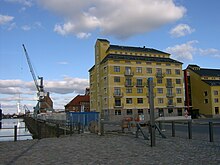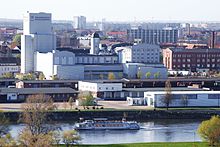Magdeburg trading port
The Magdeburg trading port is one of the four Magdeburg ports .
history
The growth of the Port of Hamburg as a result of the increasing flow of goods around 1885 also led to the need for additional storage and transshipment points in the hinterland. Due to the good ice-protected and flood-free location, the Neustädter Kämmereiwerder in Magdeburg came into question as a port location . The then royal government in Berlin allowed the Magdeburg magistrate to build the port as early as 1878.
Construction work began in 1888, with the two storage buildings still standing today with a clinker facade . The 994 meter long and between 45 and 65 meter wide harbor basin of the commercial port was completed in 1893. The quay consists predominantly of gravity walls , is located in the northern part a geböschtes provided with natural stone paving shore. At the end of the 19th century, the GHI storage blocks were built west of the harbor basin .
A special feature was the technical equipment with a steam system that supplied a hydraulic system with pressure, the eleven mobile gantry cranes (with one to three tons load capacity), a lifting bridge (over the port access) and the stationary heavy-duty crane "Elefant" (21 tons load capacity) moved. In addition, four mobile steam cranes (similar to the conventional steam excavators) were in use. The port also had its own track system with a fleet of vehicles (locomotive, freight wagons) and its own tugboat to support the arriving cargo ships.
The construction costs for the port facility at that time were estimated at around 8 million marks . The port was put into operation on April 5, 1893, the highest turnover was reached in 1906 with around 1.4 million tons of goods. The goods handled mainly came from the region, including grain, sugar, salt, wood, animal feed and fertilizers. Exotic goods such as coffee were also handled. The R. Wolf locomotive factory in Magdeburg-Buckau, founded in 1862, loaded the "Elefant" boiler and other machine parts from its production. As a result of the construction of the deeper and generally larger industrial port , the handling figures fell from 1908. Later, the lack of water level regulation had a negative impact on the development of the port. Between 1935 and 1938 a grain silo was built to the south of the GHI storage blocks.
Present and Future
The commercial port is to be converted into a museum or science port .
The Museum of Technology Magdeburg shows the nacelle, the heavy-duty crane "elephant", the divers bay II , a bucket brigade floats, dredgers and the lift bridge and a historic railway exhibition. The full gantry luffing crane built in 1956 is also located in the port . In addition, the last chain steamer of its kind, the " Gustav Zeuner " , is set up on the listed lift bridge and bears witness to the developments of the designers Ewald Bellingrath ( grab wheel for the chain) and Gustav Anton Zeuner (turbine propeller for the descent without a chain). In the immediate vicinity of the port is the Alte Neustadt locomotive shed , which was built in 1863 and at times belonged to the port railway .
In a first step, two old granaries in the southern area were converted by 2007 under the name “think tank” for office use by innovative companies and research institutions. Before that, the “Virtual Development and Training Center” VDTC of the Fraunhofer Institute for Factory Operation and Automation IFF was established in 2006 at the old trading port .
literature
- State capital Magdeburg (Ed.): Magdeburger Verkehrsanlagen. Magdeburg 2001.
Web links
Coordinates: 52 ° 8 ′ 33 ″ N , 11 ° 39 ′ 25 ″ E







